Ecological Wood Protection System against Fire, Fungi and Insect Damage Using Humic Acids and Fly Ash
Abstract
:1. Introduction
2. Materials and Methods
2.1. Experimental Setup
- (1)
- Test specimens were cut from various species of wood.
- (2)
- The test specimens were dried at 105 °C for 48 h.
- (3)
- Humate solutions were prepared. Humates were extracted from black peat using ammonia solution, and a highly concentrated humate solution (exceeding 3%) was obtained.
- (4)
- Colloidal oil shale ash, colloidal silica, and humate were mixed, and the test specimens were placed into a mixer using special holders. The system was vacuumed to remove air veins in the wood. The air was slowly reintroduced into the system while the impregnation solution was kept moving by a mechanical mixer.
- (5)
- Test specimens were rinsed with water and dried.
- (6)
- Cuts of the test specimens were made, and SEM studies were performed to determine the quality of impregnation and the chemical composition of the crystals formed.
- (7)
- Another part of each test specimen was placed into a termite colony.
- (8)
- The third fraction of each test specimen was used in the fire-resistance tests using a cone calorimeter.
2.2. Preparation of the Specimens
- Wood Specimens: Two different sizes of wood specimens, measuring 30 mm × 30 mm × 10 mm and 50 mm × 50 mm × 10 mm, were cut from various wood species, including Scots pine (Pinus sylvestris), Norway spruce (Picea abies), silver birch (Betula pendula), black alder (Alnus glutinosa), aspen (Populus tremula), ash (Fraxinus excelsior), and oak (Quercus robur). The specimens were subsequently dried (Figure 1) and marked.
2.3. Preparation of Humate Solution and Impregnation Solution, and Vacuum Impregnation Procedure
- Humate solution preparation: A humate solution was prepared by mixing well-decomposed dark peat with warm water (36–40 °C) and 25% liquid ammonia (5 vol % mixture).
- Impregnation solutions: Five impregnation solutions were created using the humate base solution:
- Humate base solution (500 mL) with 50 g of ground oil shale ash and 20 g of silica fume.
- Humate base solution (500 mL) with 50 g of oil shale ash.
- Humate base solution (500 mL) with 20 g of silica fume.
- Humate base solution (500 mL).
- Distilled water (500 mL) with 50 g of oil shale ash and 20 g of silica fume.
- Vacuum impregnation: Specimens were impregnated within a vacuum tank (see Figure 2). The vacuum was set to −1.0 bar for 1 h to remove air from the wood. Subsequently, the specimens were immersed in the impregnation solution, allowing it to penetrate the wood’s veins for 24 h. Afterward, the specimens were rinsed with water and dried at 105 °C for 24 h.
2.4. SEM Studies
2.5. Tests with Termites
2.6. Fire Tests
- Total heat release;
- Total oxygen consumed;
- Mass loss;
- Average specific mass loss rate;
- Total smoke release;
- Total smoke production (6.0 m²);
- Mean peak time;
- Heat release rate;
- Effective heat of combustion;
- Mass loss rate;
- Specific extinction area;
- Carbon monoxide yield;
- Carbon dioxide yield.
3. Results and Discussion
3.1. SEM Studies
3.2. Fire-Resistance Tests
- (1)
- Ignition
- Ignitability;
- Flammability;
- (2)
- Developing fire
- Flame spread;
- Heat release;
- HRR;
- (3)
- Fully developed fire
- Heat penetration;
- Fire penetration/fire resistance;
- Heat release/fire load.
- Capping effect: The concrete cork applied to the wood tracheids acts as a barrier, impeding heat flow into the material.
- Endothermic release of carbon dioxide: The decomposition of the concrete material leads to the endothermic release of carbon dioxide, which, in turn, cools the fire front and obstructs the access of atmospheric oxygen.
3.3. Tests with Termites
3.4. Impacts on Mechanical Properties and Moisture Resistance
4. Conclusions
Author Contributions
Funding
Institutional Review Board Statement
Informed Consent Statement
Data Availability Statement
Acknowledgments
Conflicts of Interest
References
- Kalt, G. Carbon dynamics and GHG implications of increasing wood construction: Long-term scenarios for residential buildings in Austria. Carbon Manag. 2018, 9, 265–275. [Google Scholar] [CrossRef] [PubMed]
- Carrington, D. World Close to ‘Irreversible’ Climate Breakdown, Warn Major Studies. The Guardian. 27 October 2022. Available online: https://www.theguardian.com/environment/2022/oct/27/world-close-to-irreversible-climate-breakdown-warn-major-studies (accessed on 19 December 2022).
- Blanchet, P.; Breton, C. Wood productions and renewable materials: The future is now. Forests 2020, 11, 657. [Google Scholar] [CrossRef]
- Falk, B. Wood as a sustainable building material. For. Prod. J. 2009, 59, 6–12. [Google Scholar]
- International Code Council. International Building Code; International Code Council, Inc., 2018; Available online: https://codes.iccsafe.org/content/IBC2018P6 (accessed on 5 February 2020).
- Przystupa, K.; Pieniak, D.; Samociuk, W.; Walczak, A.; Bartnik, G.; Kamocka-Bronisz, R.; Sutuła, M. Mechanical Properties and Strength Reliability of Impregnated Wood after High Temperature Conditions. Materials 2020, 13, 5521. [Google Scholar] [CrossRef] [PubMed]
- Ulyshen, M.D. Wood decomposition as influenced by invertebrates. Biol. Rev. 2016, 91, 70–85. [Google Scholar] [CrossRef] [PubMed]
- Hernández-Teixidor, D.; Suárez, D.; García, J.; Mora, D. First report of the invasive Reticulitermes flavipes (Kollar, 1837) (Blattodea, Rhinotermitidae) in the Canary Islands. J. Appl. Entomol. 2019, 143, 478–482. [Google Scholar] [CrossRef]
- Chu, D.; Mu, J.; Avramidis, S.; Rahimi, S.; Liu, S.; Lai, Z. Functionalized surface layer on poplarwood fabricated by fire retardant and thermal densification. Part 2: DynamicWettability and bonding strength. Forests 2019, 10, 982. [Google Scholar] [CrossRef]
- Gan, W.; Chen, C.; Wang, Z.; Song, J.; Kuang, Y.; He, S.; Mi, R.; Sunderland, P.B.; Hu, L. Dense, Self-Formed Char Layer Enables a Fire-Retardant Wood Structural Material. Adv. Funct. Mater. 2019, 29, 1807444. [Google Scholar] [CrossRef]
- Novel, D.; Ghio, S.; Gaiardo, A.; Picciotto, A.; Guidi, V.; Speranza, G.; Boscardin, M.; Bellutti, P.; Pugno, N.M. Strengthening of wood-like materials via densification and nanoparticle intercalation. Nanomaterials 2020, 10, 478. [Google Scholar] [CrossRef]
- Coudert, L.; Blais, J.F.; Mercier, G.; Cooper, P.; Janin, A. Remediation processes for wood treated with organic and/or inorganic preservatives. In Handbook of Recycled Concrete and Demolition Waste; 2013; pp. 526–554. Available online: https://www.sciencedirect.com/science/article/abs/pii/B978085709682150021X?via%3Dihub (accessed on 5 February 2020).
- Dias, K.B.; Barreiros, R.M.; Dias, K.B.; Barreiros, R.M. Preservative Treatments on Wood and Their Effects on Metal Fasteners. In Engineered Wood Products for Construction; Intech Open: London, UK, 2021. [Google Scholar] [CrossRef]
- Rabajczyk, A.; Zielecka, M.; Malozieć, D. Hazards Resulting from the Burning Wood Impregnated with Selected Chemical Compounds. Appl. Sci. 2020, 10, 6093. [Google Scholar] [CrossRef]
- Park, B.-K. Fireproofint Treatment Method Using Water Glass. WO2004062815A1, 16 January 2003. Available online: https://patents.google.com/patent/WO2004062815A1/en (accessed on 5 February 2020).
- Prabhakar, M.N.; Shah, A.U.R.; Song, J.-I. A Review on the Flammability and Flame Retardant Properties of Natural Fibers and Polymer Matrix Based Composites. Compos. Res. 2015, 28, 29–39. [Google Scholar] [CrossRef]
- Popescu, C.M.; Pfriem, A. Treatments and modification to improve the reaction to fire of wood and wood based products—An overview. Fire Mater. 2020, 44, 100–111. [Google Scholar] [CrossRef]
- Harada, T.; Nakashima, Y.; Anazawa, Y. The effect of ceramic coating of fire-retardant wood on combustibility and weatherability. J. Wood Sci. 2007, 53, 249–254. [Google Scholar] [CrossRef]
- Goldsmith, F.P. Fire Retardant Coatings: An Evaluation of Fire Retardant Coatings as a Means of Protecting Wood Panels. 2011. Available online: https://open.library.ubc.ca/collections/52966/items/1.0103122 (accessed on 5 February 2020).
- Luo, J. Ignition Properties of Panels Coated with Finishing Fire-Retardant Paints under External Radiation. Procedia Eng. 2016, 135, 123–127. [Google Scholar] [CrossRef]
- Schwarzkopf, M. Densified wood impregnated with phenol resin for reduced set-recovery. Wood Mater. Sci. Eng. 2021, 16, 35–41. [Google Scholar] [CrossRef]
- Navi, P.; Heger, F. Combined densification and thermo-hydro-mechanical processing of wood. MRS Bull. 2004, 29, 332–336. [Google Scholar] [CrossRef]
- Gilka-Bötzow, A.; Heiduschke, A.; Haller, P. The velocity of combustion in relation to the density of wood. Eur. J. Wood Wood Prod. 2011, 69, 159–162. [Google Scholar] [CrossRef]
- Chen, H.; Zhang, Y.; Zhong, T.; Wu, Z.; Zhan, X.; Ye, J. Thermal insulation and hydrophobization of wood impregnated with silica aerogel powder. J. Wood Sci. 2020, 66, 81. [Google Scholar] [CrossRef]
- Gabrielli, C.P.; Kamke, F.A. Phenol-formaldehyde impregnation of densified wood for improved dimensional stability. Wood Sci. Technol. 2010, 44, 95–104. [Google Scholar] [CrossRef]
- de Lima, A.J.M.; Iwakiri, S.; Satyanarayana, K.G.; Lomelí-Ramírez, M.G. Studies on the durability of wood-cement particleboards produced with residues of pinus spp., silica fume, and rice husk ash. BioResources 2020, 15, 3064–3086. [Google Scholar] [CrossRef]
- Yang, T.; Xia, M.; Chen, S.; Mu, M.; Yuan, G. Enhancing the thermal stability of silica-mineralized wood via layer-by-layer self-assembly. J. Therm. Anal. Calorim. 2021, 145, 309–318. [Google Scholar] [CrossRef]
- Lin, C.F.; Karlsson, O.; Mantanis, G.I.; Sandberg, D. Fire performance and leach resistance of pine wood impregnated with guanyl-urea phosphate/boric acid and a melamine-formaldehyde resin. Eur. J. Wood Wood Prod. 2020, 78, 107–111. [Google Scholar] [CrossRef]
- Caiping, L. Effect of phosphate treatment on interfacial properties of poplar fiber/high-density polyethylene composites. Compos. Adv. Mater. 2021, 30, 263498332110246. [Google Scholar] [CrossRef]
- Gebke, S.; Thümmler, K.; Sonnier, R.; Tech, S.; Wagenführ, A.; Fischer, S. Flame retardancy of wood fiber materials using phosphorus-modified wheat starch. Molecules 2020, 25, 335. [Google Scholar] [CrossRef] [PubMed]
- Slimak, K.M.; Slimak, R.A. Process of Using Sodium Silicate to Create Fire Retardant Products. US6303234B1, 14 March 1997. Available online: https://patents.google.com/patent/US6303234B1/en (accessed on 5 February 2020).
- Medina, L.; Schledjewski, R. Water Glass As Hydrophobic Additive for Natural Fi- Ber Reinforced Composites. J. Nanostruct. Polym. Nanocompos. 2009, 5, 107–114. [Google Scholar]
- Medina, L.; Schledjewski, R.; Schlarb, A.K. Process related mechanical properties of press molded natural fiber reinforced polymers. Compos. Sci. Technol. 2009, 69, 1404–1411. [Google Scholar] [CrossRef]
- Luo, X.; Gong, H.; He, Z.; Zhang, P.; He, L. Recent advances in applications of power ultrasound for petroleum industry. Ultrason. Sonochem. 2021, 70, 105337. [Google Scholar] [CrossRef] [PubMed]
- Özcan, C.; Esen, R.; Likos, E.; Kurt, Ş.; Yapici, F. The Effects of Fire Retardants Paint on Combustion Properties of Fir Wood. J. For. Fac. Kastamonu Univ. 2012, 12, 124–126. [Google Scholar]
- Liiv, J.; Teppand, T.; Rikmann, E.; Tenno, T. Novel ecosustainable peat and oil shale ash-based 3D-printable composite material. Sustain. Mater. Technol. 2018, 17, e00067. [Google Scholar] [CrossRef]
- ISO 5660-1:2015/Amd 1:2019 Reaction-to-Fire Tests—Heat Release, Smoke Production and Mass Loss Rate—Part 1: Heat Release Rate (Cone Calorimeter Method) and Smoke Production Rate (Dynamic Measurement). Amendment 1. Edition 3, 2019. Available online: https://www.iso.org/standard/75739.html (accessed on 5 February 2020).
- Dewaghe, C.; Lew, C.Y.; Claes, M.; Belgium, S.A.; Dubois, P. Fire-retardant applications of polymer-carbon nanotubes composites: Improved barrier effect and synergism. In Polymer–Carbon Nanotube Composites; Woodhead Publishing: Sawston, UK, 2011; pp. 718–745. [Google Scholar] [CrossRef]
- Schartel, B.; Hull, T.R. Development of fire-retarded materials—Interpretation of cone calorimeter data. Fire Mater. 2007, 31, 327–354. [Google Scholar] [CrossRef]
- Blomqvist, P.; McNamee, M.S.; Thureson, P. Compilation of International Building Regulations (Fire) Relevant for EPS/XPS: SP Technical Note 2010:10, Revised 2011-11-30. Fire Technology. 2011. Available online: https://www.researchgate.net/publication/324038076_Compilation_of_International_Building_Regulations_Fire_Relevant_for_EPSXPS (accessed on 6 September 2021).
- White, R.H.; Dietenberger, M.A. Cone Calorimeter Evaluation of Wood Products. Recent Adv. Flame Retard. Polym. Mater. 2004, 331–343. Available online: https://www.fs.usda.gov/treesearch/pubs/8450 (accessed on 6 September 2021).
- Zhang, M.; Li, H.; Wang, C.; Wang, Z.; Liu, D.; Yang, T.; Deng, Z.; Yuan, G. Performance Enhancement of the Poplar Wood Composites Biomimetic Mineralized by CaCO3. ACS Omega 2022, 7, 29465–29474. [Google Scholar] [CrossRef]
- May, A.K.A.; Shamsuddin, R.; Hau, L.J.; Aqsha, A.; Mansor, N.; Mustapa, N.I.; Narasimha, M. Investigation of pesticidal ability of humic acid derived from palm oil Empty Fruit Bunch (EFB) vermicompost. Int. J. Recycl. Org. Waste Agric. 2020, 9, 237–247. [Google Scholar] [CrossRef]
- Savy, D.; Di Meo, V.; Verrillo, M.; Cangemi, S.; Cozzolino, V.; Piccolo, A. Novel Nanomaterials Made of Humic Substances from Green Composts and Chitosan Exerting Antibacterial Activity. ACS Sustain. Chem. Eng. 2023, 11, 9674–9683. [Google Scholar] [CrossRef]

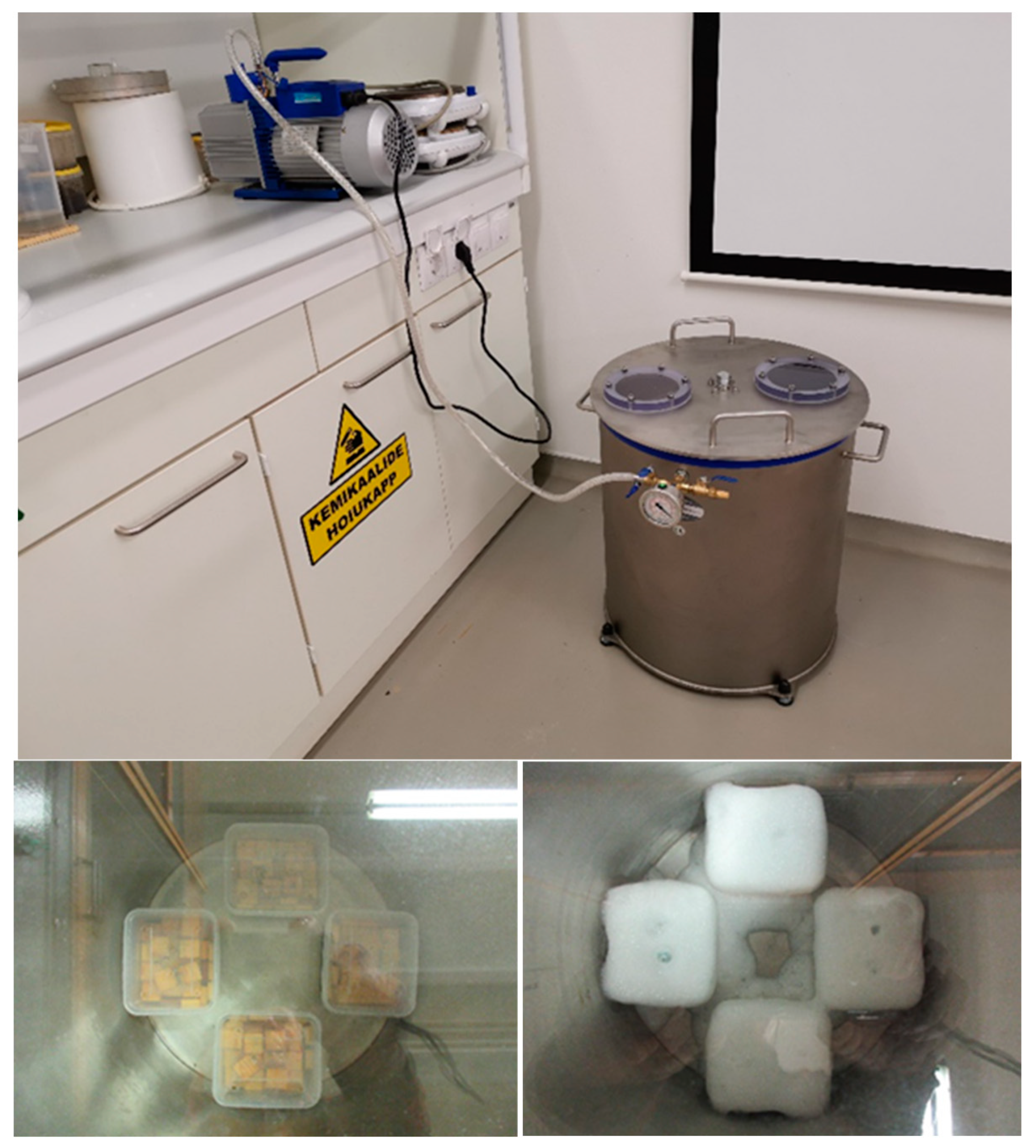
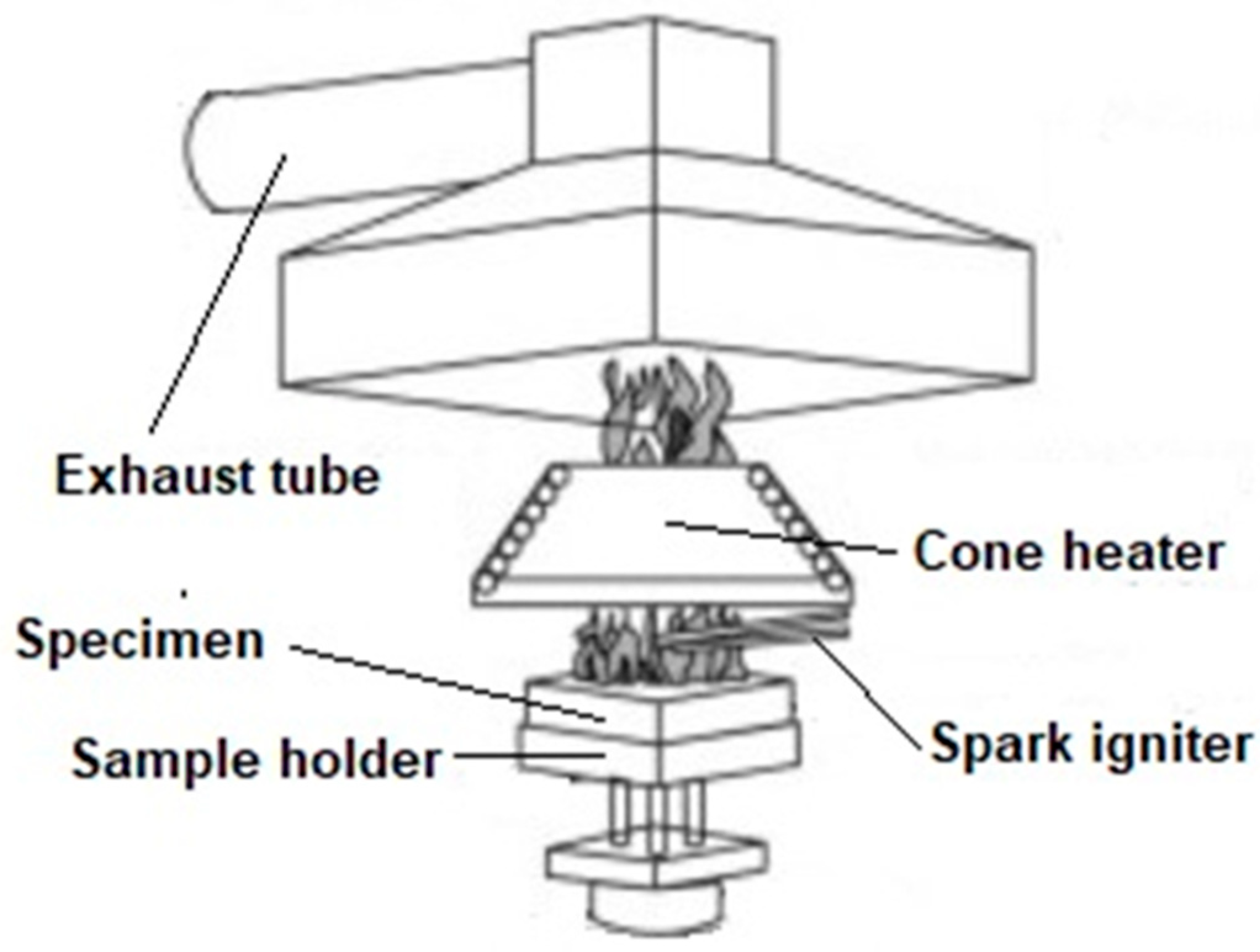

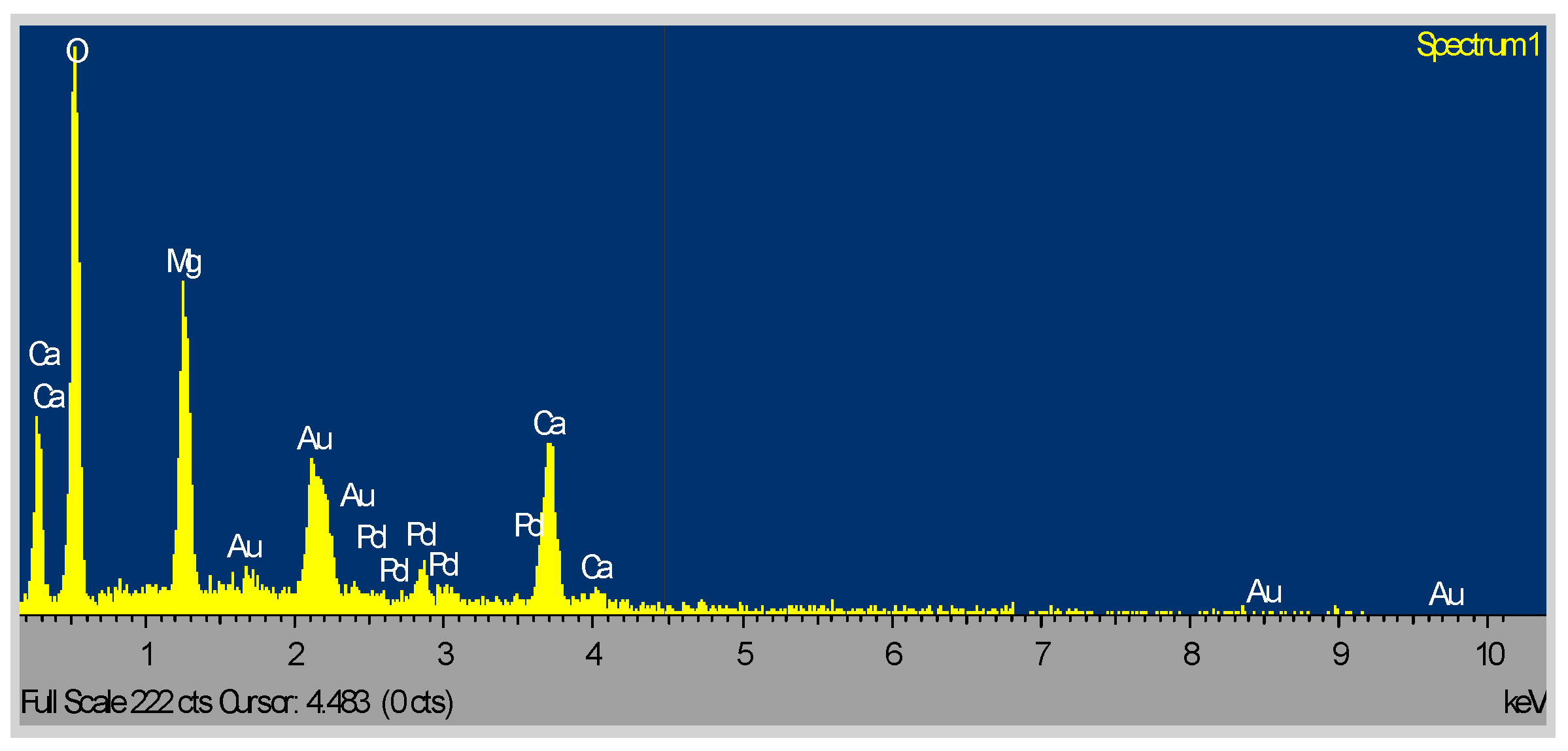
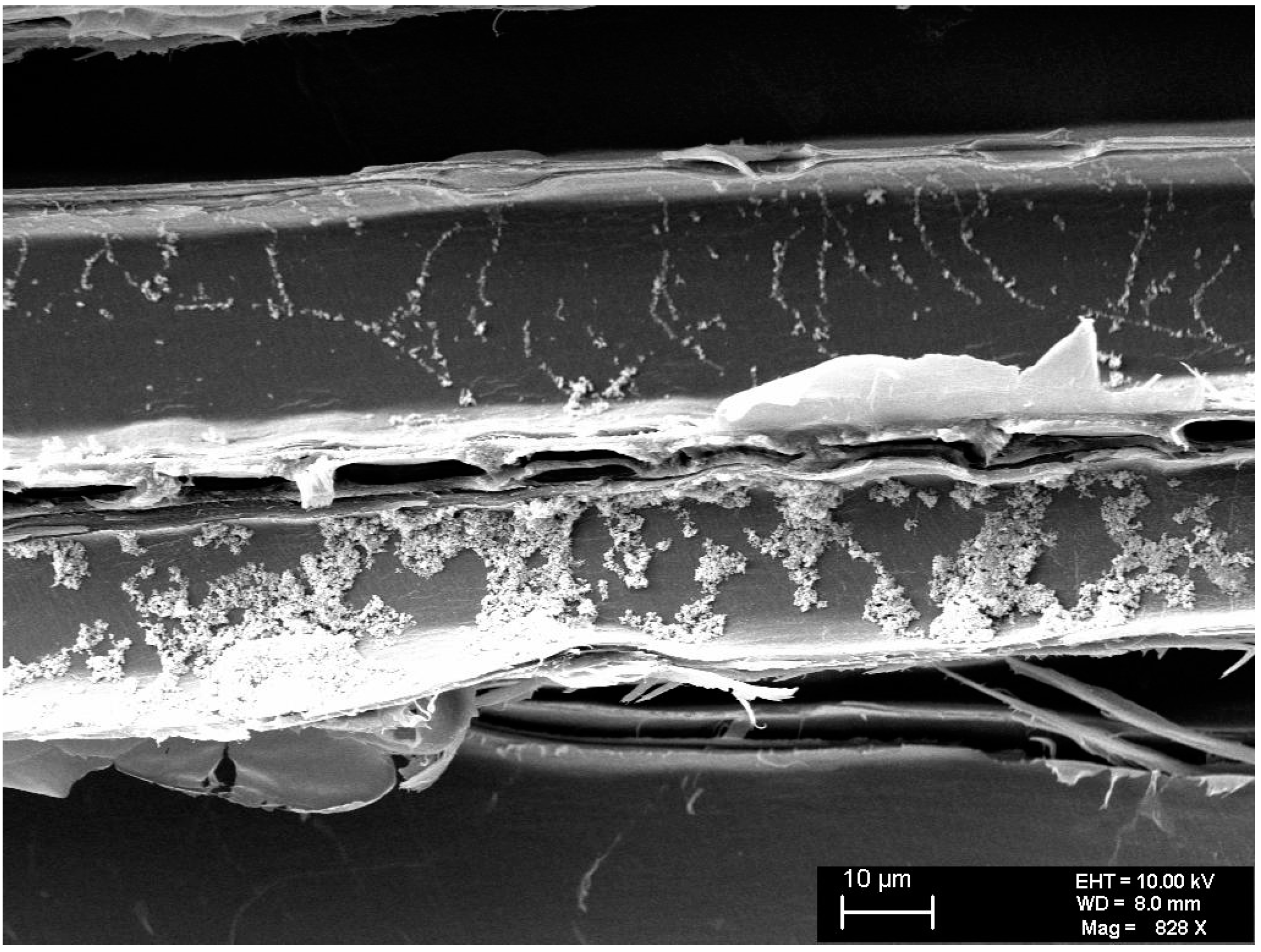
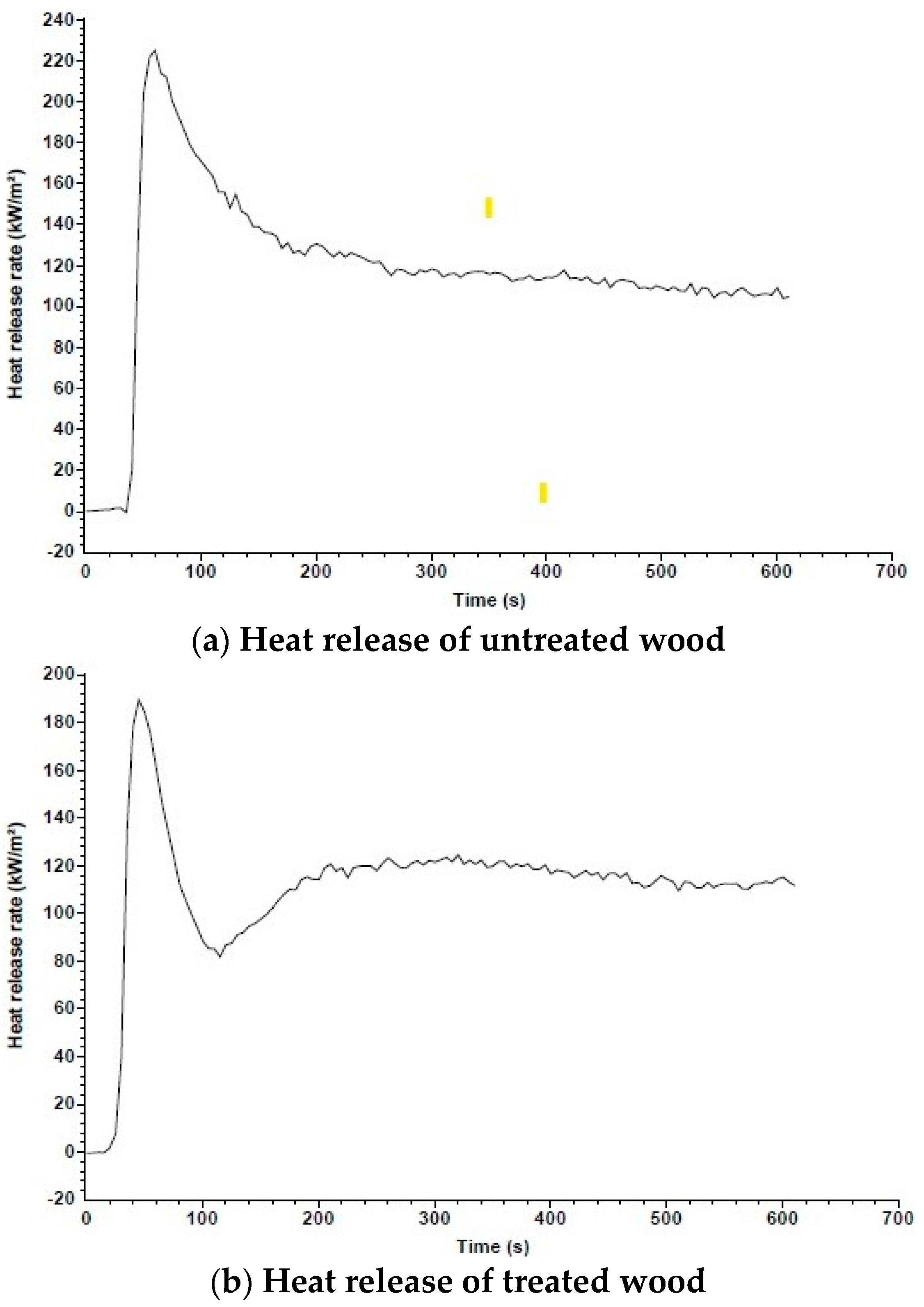
Disclaimer/Publisher’s Note: The statements, opinions and data contained in all publications are solely those of the individual author(s) and contributor(s) and not of MDPI and/or the editor(s). MDPI and/or the editor(s) disclaim responsibility for any injury to people or property resulting from any ideas, methods, instructions or products referred to in the content. |
© 2024 by the authors. Licensee MDPI, Basel, Switzerland. This article is an open access article distributed under the terms and conditions of the Creative Commons Attribution (CC BY) license (https://creativecommons.org/licenses/by/4.0/).
Share and Cite
Liiv, J.; Rikmann, E.; Shanskiy, M.; Teppand, T. Ecological Wood Protection System against Fire, Fungi and Insect Damage Using Humic Acids and Fly Ash. Appl. Sci. 2024, 14, 5179. https://doi.org/10.3390/app14125179
Liiv J, Rikmann E, Shanskiy M, Teppand T. Ecological Wood Protection System against Fire, Fungi and Insect Damage Using Humic Acids and Fly Ash. Applied Sciences. 2024; 14(12):5179. https://doi.org/10.3390/app14125179
Chicago/Turabian StyleLiiv, Jüri, Ergo Rikmann, Merrit Shanskiy, and Tõnis Teppand. 2024. "Ecological Wood Protection System against Fire, Fungi and Insect Damage Using Humic Acids and Fly Ash" Applied Sciences 14, no. 12: 5179. https://doi.org/10.3390/app14125179







